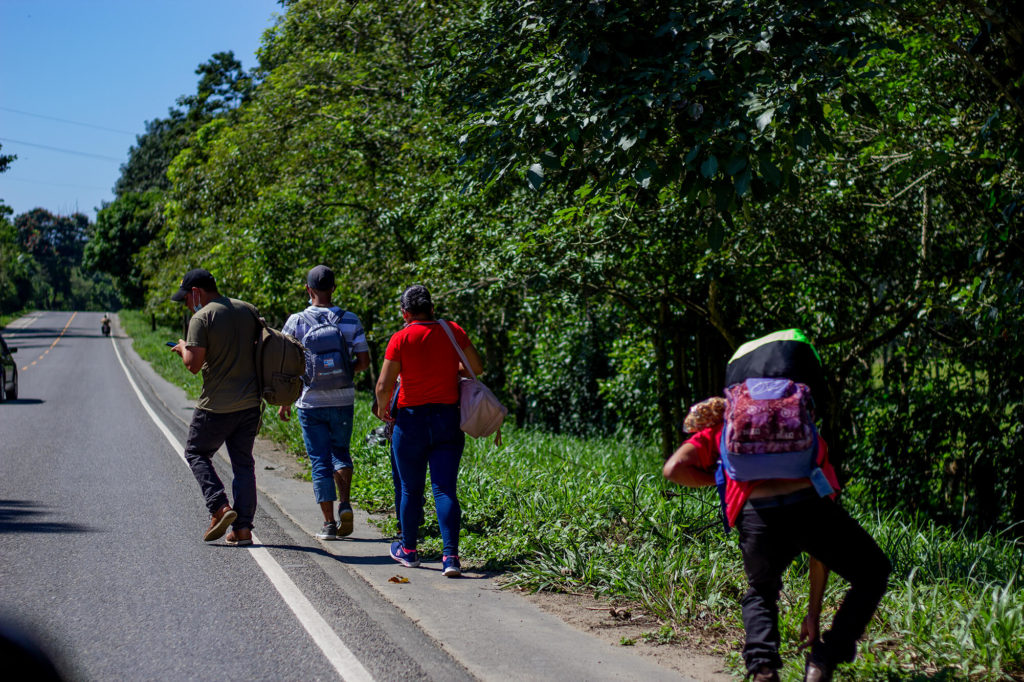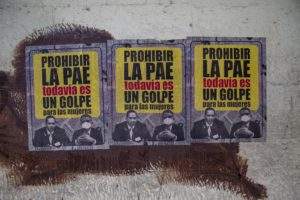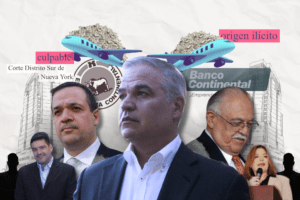The first migrant caravan for the year departed from the San Pedro Sula bus terminal in Honduras on January 15. Almost half are Nicaraguans.
By Allan Bu
Photos by Antonio Gutiérrez
It’s after 10:00 on a Friday night. People are lying on the grass in front of the San Pedro Sula bus terminal. They seem to be at ease, but when we ask what time the caravan is leaving, their survival instinct immediately kicks in. “Where are your media credentials?” they ask. They are Nicaraguan citizens fleeing Daniel Ortega’s administration and have joined the first migrant caravan of 2022.The group of at least 600 people began walking early on January 15 towards the Corinto border crossing to Guatemala.
“If we talk to you and don’t make it through, we may not be able to return home,” said a burly man who seems to be the spokesperson for the Nicaraguans. Although about half of the caravan are Nicaraguans, there are also Haitians, Hondurans, Venezuelans, and even Africans.
The caravan is setting out five days after Daniel Ortega was sworn in as president of Nicaragua.He secured his fourth consecutive term in a disputed election last November. Only three presidents attended his inauguration; Juan Orlando Hernández of Honduras, Nicolás Maduro of Venezuela, and Miguel Díaz-Canel of Cuba.
Read (in Spanish): Analysts say Hernández attended Ortega’s inauguration out of self-interest and to return a favor
“People who oppose [Ortega’s] government are being kidnapped or thrown in jail,” says another man. Showing his fear of Ortega’s administration, he says, “We can’t give you our names because our families are still there. They’ll screw us over ─ the government is capable of anything.” He tells us that he and his two sons were in jail and that he’s going to the United States because anyone who protests in Nicaragua is persecuted. A tall man in a red shirt who was also jailed in Nicaragua, says that he is fleeing the country because his father was arrested, shot in the head, and killed.
In April 2018, protests against Ortega’s reforms to Nicaragua’s social security system swept the country. Spanish media outlet El País reported that over 300 people were killed during the protests as of July 2018.
To get out of Nicaragua, migrants avoided official border posts and walked into Honduras at various blind spots, sometimes paying to get across. One migrant said, “No one can leave through [official] border posts. His [Ortega’s] army is everywhere. We paid to get through.” He told us that lots of people paid US$250 to travel on tourist excursions to Guatemala, where many of his compatriots are waiting to join the caravan when it comes.
Read (in Spanish): Their dreams dashed, a migrant caravan is turned back
Some migrants who paid the human trafficking mafia to take them to the United States say it costs US$7-10,000 per person. But most people who join caravans travel with whatever they have on their backs, spurred on by their faith and hope for a better future.
One migrant told us, “We need to pray to God that the caravan will be able to go forward. Look, if we tell them what we’re going through in Nicaragua, that we can’t go back there, I don’t think they’ll stop us.”
Honduran authorities held up the Nicaraguans for a few minutes, but although they didn’t have the documents needed to cross the border officially, they were not prevented from crossing elsewhere. Several Honduran officials showed them where they could walk into Guatemala.
Most of the Nicaraguans in the caravan learned about it through social media. Many of them think that there will be a mass exodus from the country. “Nicaragua is going to be like Maduro in Venezuela ─ everyone emigrated,” said a voice from the crowd. “You see reports that there’s no problem in Nicaragua, but most people with jobs are living off the government tit and are under some sort of threat.”
Will the caravan be able to go forward?
Among the 600-person caravan are Hondurans like Nery Paz, a 51-year-old day laborer from San Marcos, Santa Barbara, in western Honduras. This is his second try at getting to the United States. Paz said, “I’m going with the caravan. The work here doesn’t pay anything. Lord willing I’ll get there and build a better life.”
Later on, we meet Javier, who’s trying to get to the United States for the fourth time. He told us that he hasn’t had a real job in four years. With two children, he needs to think about his future. “There’s nothing here for us. Maybe the country will get better, but it won’t happen quickly. When someone is very sick, they get better slowly. And Honduras is sick,” he says.
In January 2021, more than 7,000 Hondurans set out from San Pedro Sula in the first migrant caravan of that year. The caravan had hoped to make it to the United States but it was surrounded in Guatemala and broken up with tear gas and billy clubs.
According to data from the Honduras Consular and Migration Observatory (Observatorio Consular y Migratorio de Honduras – CONMIGHO), 52,968 Hondurans were repatriated in 2021. Most were stopped at the US-Mexico border and sent back to Honduras, while others were deported from the United States.








